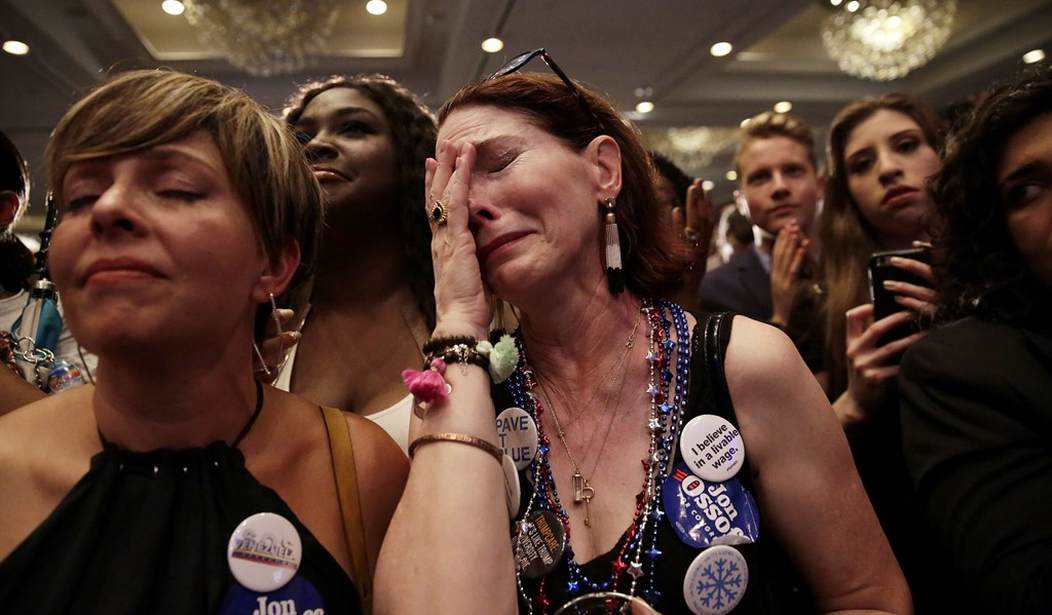The Democrats are lusting for the House takeover. In some weird way, they see their 0-4 record in special elections as an indicator that they’ll retake the lower chamber. Democrats say they’re over performing in these elections. Democrats say this is a good sign. Everyone else says they’re still losers, even CNN.
Rep. Jan Schakowsky (D-IL) from the People’s Republic of Illinois said that she feels confident that Democrats will pick up 25 seats. Well, from the concrete fortress of urban, progressive America, that may be a possibility—just as this cohort thought that Hillary Clinton would win in a landslide. Everyone else, even The New York Times, is not so sure.
MSNBC’s Morning Joe tossed a wet blanket on the notion of a Democratic wave, noting the difficulties with candidate recruitment—no solid standout candidates—and the lack of a farm system to find those candidates. Nate Cohn at The New York Times noted that Democratic turnout for the GA-06 special election was the highest in a decade, but added that a) the Democratic path to the majority runs through red districts and Jon Ossoff’s defeat in Georgia showed the level of difficulty on that front; and b) even with the high Democratic turnout, the electorate could mirror that of 2016 which was favorable to Trump. In all, even with President Trump’s less than stellar approval rating, which usually is a good indicator for how midterm elections turn out for whichever party is occupying the White House, the GOP could retain the majority.
We’re not fighting an unpopular war that was growing increasingly out of control and corruption scandals haven’t hit the GOP leadership. Also, the Democrats were much more exposed heading into 2010 than Republicans. Also, for Democrats to win districts that trend Republican, having Rep. Nancy Pelosi (D-CA) as the face of the party is a recipe for disaster. The House Minority Leader proved to be a contributing factor to Ossoff’s defeat to Republican Karen Handel in the most expensive House race in history. Rep. Tim Ryan (D-OH), who challenged Pelosi for the leadership position, conceded that she is more toxic than Trump in some parts of the country, and that the Democratic Party brand is just terrible right now. All of this isn’t necessarily the making for headwinds into these red districts. Now, Third Way, a left of center think tank, released a study showing that even if the Democrats sweep the suburbs, they’ll still fall short (via WaPo) [emphasis mine]:
Recommended
The opposition party needs to win 24 seats to take control of the House in 2018. Understandably, operatives and handicappers have focused on the 23 districts that Republicans hold, which voted for Hillary Clinton last year. But some of the incumbents are very popular, with brands that are distinct from Trump’s, and they are unlikely to lose no matter how bad the headwinds become.
In other words, it’s inconceivable that Democrats run the table in those 23 districts. Even if they did, they’d still be one short. And Democrats must defend 12 seats in districts that Trump carried in 2016.
Third Way did a deep dive to try to understand what the 2018 playing field will look like. The center-left think tank focused on 65 “Majority Makers,” the battlegrounds where a majority would most likely be won.
[…]
They divided the swing districts into four categories: Thriving Suburban Communities, Left Behind Areas, Diverse/Fast-Growing Regions, and Non-Conformist Districts.
[…]
The numbers underscore how different even the 23 GOP-held Clinton districts are demographically. Many are suburban and overwhelmingly white. Others are rural and heavily Latino. Within the broad categories, there are stark differences on income, educational attainment and employment rates. More than half of adults in New Jersey’s 7th District, for example, graduated from college. Only 17 percent in California’s 10th District did.
“The most important takeaway is that there is no one kind of voter or district that can deliver the House for Democrats in 2018,” said Lanae Erickson Hatalsky, the vice president for social policy and politics at Third Way. “There’s been a lot of focus on suburban districts. There’s no doubt that those are important, but there are not enough of them to win the House.”
Hatalsky, who co-authored the report with Ryan Pougiales, emphasized that Democrats still would not win the House even if they could get every single 2016 Clinton voter who backed a Republican House candidate to turn out again in 2018 and cross over.
“You can’t get to a House majority without winning over Trump voters,” she said. “There are some people who definitely want to believe that they can because they still don’t know how to deal with Trump voters and are intimidated by the idea of appealing to them.”
Well, that certainly is a splash of cold water on those Democratic wave hopes. As of now, looks like low tide for the Left.
























Join the conversation as a VIP Member